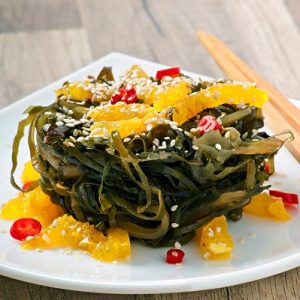 Seaweed is a classification of foods that are found in the salt water of the ocean. They are extremely nutrient-dense so contain a great deal of nutrients calorie per calorie, making it a superfood you won’t want it to miss.
Seaweed is a classification of foods that are found in the salt water of the ocean. They are extremely nutrient-dense so contain a great deal of nutrients calorie per calorie, making it a superfood you won’t want it to miss.
Seaweed Benefits
Seaweed, as a class of foods, has many health benefits. These include the following:
High Calcium Levels
Seaweed can give you as many as ten times more calcium than regular milk and 8 times the calcium as beef.
Purifies the Blood
Seaweed has the chemical makeup of our blood, which makes it an excellent blood purifier.
Alkalizes the Blood
Because we eat too many acidic foods, seaweed should be eaten along with them to prevent the blood from being too acidic.
Chelates the Blood
Seaweed helps by protecting us from the various environmental toxins, such as pollutants, radiation, and heavy metals, which become harmless seaweed salts that can be gotten rid of by the body very easily.
Detoxifies the Blood
Seaweed is high in chlorophyll, which makes it a natural and strong detoxifier, drawing away waste products from the blood stream.
Weight Loss Food
Seaweed can help you lose weight by increasing weight loss and blocking the formation of cellulite. They are high in iodine, which is necessary in the function of the thyroid gland, which controls our metabolism. It is high in minerals that can help unseal the fat in fat cells so that it can become a waste product in the body.
Types of Seaweed
There is not just one kind of seaweed. In fact, there are many kinds you can incorporate into your diet. These include the following:
- Kelp – This is also called brown algae. It is the most common type of seaweed in the edges of the ocean. You can get this as a supplement
- Nori – This is the seaweed used to make sushi. Use untoasted sheets, however, which have the most nutrition in them.
- Dulse – This is also called red seaweed. You can purchase it in flakes ow whole. The flakes can be added to any dish. While dulse should be soaked and sliced before using it in a recipe. It seasons soups, vegetables, and salads.
- Arame – It is a type of black, stringy seaweed. It is usually soaked before adding to dishes. It will double in size when soaked. You can add it to stir fry, grains, curries, salads, and soups.
- Wakame – It can be purchased dehydrated or fresh. It tastes best when soaked before using. Put it in stocks, stir-fries, soups, or other savory dishes.
- Kombu – This is used as a flavor enhancer in Japan. It is rich in minerals and can be used with beans in order to lessen the gas from the beans. It can be used with sprouts, which soak up the minerals in the seaweed.
Make sure you select organic types of seaweed that are certified. Seaweed can easily absorb pollution so you should have seaweed that is harvested from water that has not been polluted and is pure.
Health Benefits of Seaweed
Seaweed has been used to extend life and to increase health. For many years, seaweed was eaten to improve nutrition. It contains many types of minerals, which make up more than a third of its dry weight. It is also high in calcium, EPA, alpha linoleic acid, fiber, vitamin B, protein, vitamin C, vitamin A, magnesium, and iron.
Nori is especially used for its mineral content and is high in vitamins, even more so than fruits and vegetables. It is also high in fiber.
Sundried or raw seaweed is high in the following:
- Protein, with 20 percent protein in green algae and 79 percent protein in spirulina
- Vitamin C
- Minerals, especially calcium, iodine, magnesium, and iron
- Iodine for thyroid function
- Anti-inflammatory properties
- Anti-bacterial properties
- Antiviral properties
- Plant-based calcium
- Polysaccharides useful in managing heart disease, diabetes type 2, liver function, and blood sugar
Health Benefits of Seaweed
It has been found to be healthy for promoting hearing, aiding memory, improving skin quality, teeth, eyesight, thyroid function, immune function, infections, allergies, high blood pressure, high cholesterol, getting rid of wastes and improving digestion. It is eaten in sushi or as a salad.
Recipe for Seaweed Salad
Seaweed salad is incredibly good for you and you can use just about any type of raw, untoasted seaweed. Tamari is used instead of soy sauce.
Ingredients
Any type of raw untoasted seaweed
Stevia for sweetness
Lemon juice
Tamari
Sesame seeds
Sesame oil
Directions
Mix the oil, stevia, soy, and lemon juice. Toss with seaweed and sprinkle on sesame seeds. Then enjoy!
Nutrition in Seaweed Salad
A serving size is one ounce of seaweed salad. It contains about 35 calories, 2 grams of fat, no cholesterol, 425 mg of sodium, no potassium, 5 grams of fiber, 4 grams of sugar, and 0.5 percent protein.






